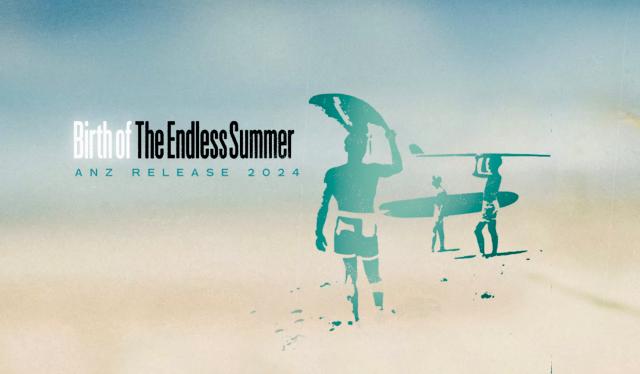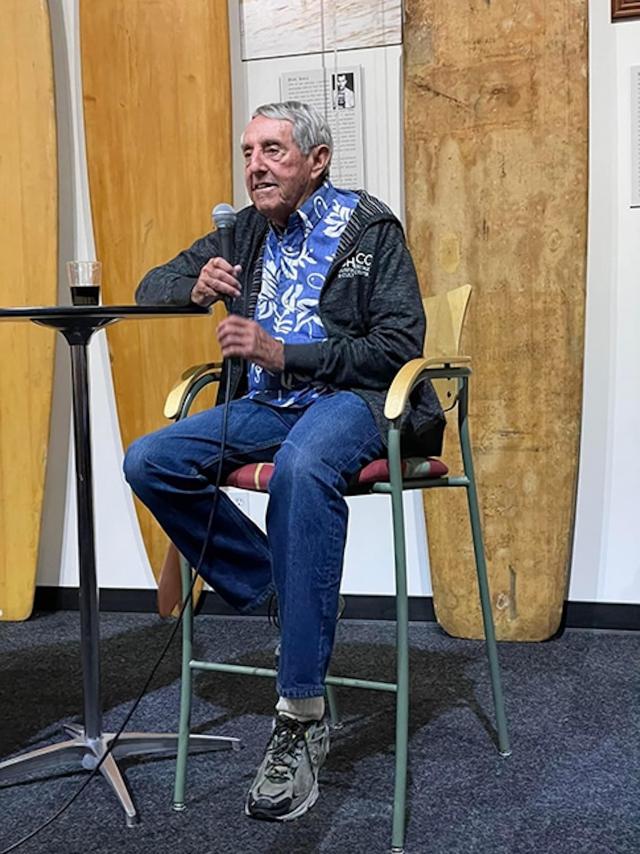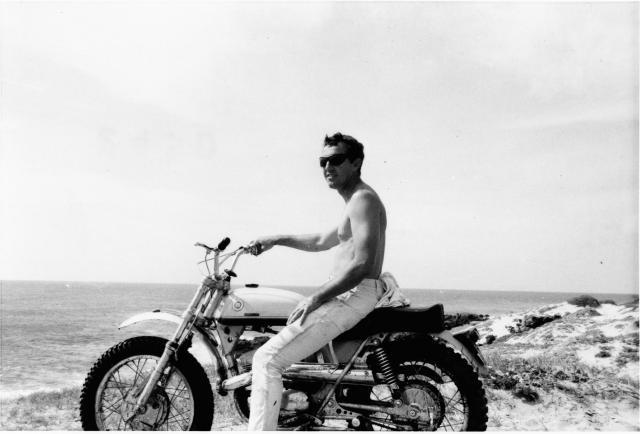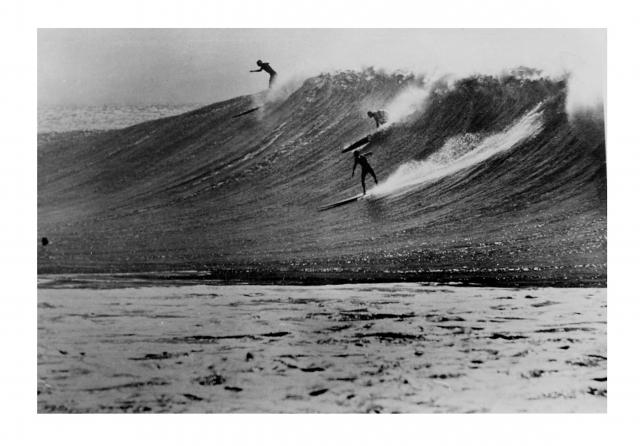
When I went to live in Laguna Beach, California, 20 years ago, to me Dick Metz was chiefly famous for owning The Spigot, an excellent liquor and wine store at the bottom of my street.
We soon developed a nodding acquaintance whenever he happened to be at the store, or more likely sitting on the bench out front and talking story with other salt-encrusted locals. I guessed he had a surfing background but didn’t know the half of it until I went along to the recently-opened Surf Heritage and Culture Centre in San Clemente one night for a surfing talk show and Dick was on the panel. I discovered that not only had he co-founded the Surf Heritage Foundation in 1999 and that many of the most historic surfboards exhibited at SHACC were from his private collection, but that he had more or less invented the surf retail and travel industries in the US and Hawaii, at one point owning 22 shops in California, Florida and Hawaii, including the Hobie chain, and had pioneered surfing at several of the iconic surf breaks of the world. He was described – never by Dick himself – as “the most important man in surfing you’ve never heard of”, and “the Forrest Gump of surfing, always on the edges of history, mostly evading mention or fame”.
But even after absorbing all of this, I still wasn’t close to understanding the whole picture of this fascinating man, now 94, until I watched director Richard Yelland’s absorbing documentary, The Birth of the Endless Summer (yes, Metz invented that too) which has its Australia/New Zealand premiere on the opening night of the Noosa Surf Festival next Friday 8 March at The J.
The film tells the story of how the crazy travel adventures of a wise-cracking, party-loving, chick-hugging California beach bum with a dash of business savvy convinced his surf-filming buddy Bruce Brown to make The Endless Summer, which since its premiere 60 years ago has become the most-watched documentary of all time, inspiring generations of surfers and adventurers – this one included – to grab a board and a backpack and take the road least travelled.
Born in Laguna Beach in 1929, Dick Metz’s earliest memories are of playing on the rocky beach at Oak Street with child star Shirley Temple while her parents lunched at his dad’s famous restaurant on the cliffs. His next memories are as a seven-year-old, riding tandem at San Onofre’s friendly rollers with surf legends Peanuts Larson and Hevs McClelland. Within a year or two he was borrowing their heavy redwood boards and riding waves by himself.
After graduating from Santa Barbara State College and doing a stint in the army, he found himself back in Laguna in 1954, with the post-World War II surf scene starting to boom.
Dick teamed with his surf pal Hobie Alter in the launch of the landmark Hobie Surf Shop in Dana Point, the first purpose-built surf shop in the world which would become the blueprint for a lifestyle, culture and industry that was to soon blossom.
Business was good and one Hobie store soon became a chain. But Dick had the travel bug … bad. Apart from numerous trips to Hawaii to ride the big waves of Makaha, he hadn’t seen much of the world, and as he sat in the barber shop reading True and Argosy mag stories about bare-breasted beauties on remote tropical beaches while he waited for his college cut, he developed a plan. His dad had helped set him up in another restaurant, so he sold that, his car and anything else dispensable, and with two grand left after paying down his debts, in 1958 he hopped a freighter from Mexico, finally washing up in Tahiti.
From there he spent the next three years wandering and looking for waves across the Pacific to Australia, then on to South East Asia, India and eventually Africa, where one dark night a hitched ride landed him at Victoria Falls. Dick recalls: “I looked out the window, it’s one in the morning, I could see a couple of fires and two or three little huts, but no lights, nobody around, no real buildings of any kind. I really didn’t want to hang around, and since the driver was bound for Cape Town, I just stayed in the car. And that was how I met John Whitmore.”
A funny-looking guy with a goatee and pointy features, Whitmore was regarded as the father of South African surfing, such as it was in 1959. As Metz says in the film: “They really didn’t know much about it, but they were so eager to learn, and no one more so than John, who took me into his home, we became firm friends and we started exploring the coast for surf.”
On one of these trips Whitmore took him to the very tip of the Eastern Cape, to a village called Cape St Francis, where Dick saw the kind of surfing line-up that surfers dream about, lines of swell running down a long sandbar framed by a rocky beach. The boys got wet but this particular day it was really nothing to write home about. However Metz saw the potential and logged it into his memory bank, and his travel notes.
Back home in California in 1962, Dick and his buddy Bruce Brown were enjoying a few brews at a bar in Dana Point when Brown shared his big idea. After several years of producing a surf documentary every summer and showing it around college halls to make enough for the next one (often, pre-1959, with Dick helping him run the shows), Brown was going to mortgage the house and stake everything on a vast exploration of the unknown surfing world, and Dick was going to tell him where to go.
It was a good idea and Dick was a generous friend. After digging out his travel diaries and moving onto a good bottle of bourbon, Dick gave him the lowdown on the waves of Tahiti, Australia and beyond. Then he got to South Africa and described the waves he’d surfed from Cape Town to Durban, before pausing, taking a slug from his glass and revealing: “And there’s this little remote place called Cape St Francis that looked really interesting.”
The rest, as they say, is history. In 1963 Bruce Brown flew his surfers Mike Hynson and Robert August (seen getting on and off planes in ridiculous business suits) to South Africa and eventually they made their way to the Eastern Cape and to Cape St Francis, where the most magical scenes of Brown’s iconic Endless Summer were shot in just under 90 minutes, while the tide was right and Hynson and August rode wave after perfect wave alone at the surf break that would become known as “Bruce’s Beauties”.
For the filming of The Birth of The Endless Summer a few years back, director Richard Yelland took Metz, then 90, back to Cape St Francis, which looks a lot like modern Noosa, with its canal estates and low-rise waterfronts. And guess what? It was flat again, as it frequently is. The camera shows the old man staring wistfully out to sea, a sly smile creasing his lips.
Bruce Brown, now departed, gave his name to a famous surf break and made his fortune with the phenomenal success of Endless Summer, some of that thanks to what we might call Metz Magic, but until now, Dick has been very much the silent partner.
Regrets? Nah, Dick Metz doesn’t do regret. Life’s too short.
The Noosa International Surfilm Festival presents Birth of The Endless Summer, The J, 6pm Friday 8 March.













